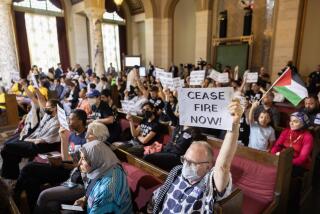Community Contact Vital to Curbing Gang Violence, Police Told : Crime: At a summit meeting, neighborhood activists and politicians urge authorities to find a new approach.
Law enforcement must work more closely with the communities they police if gang violence is to be curbed, neighborhood leaders told a “summit” meeting on gangs in Pico Rivera on Tuesday.
“The folks don’t know the cops, and the cops don’t know the folks,” said Connie Armenta of the United Neighborhoods Organization in East Los Angeles. Police have to “get to know the gangbangers,” she said. “We need social confrontation from the police--not violent confrontation.”
Val Rodriguez of the San Gabriel Valley’s East Valley Organization urged authorities to “get to know the communities to get at the gang problem. You need a new approach.”
He said, for example, that police in El Monte, where he lives, should “walk the streets and knock on doors” and talk to parents to see what needs to be done.
“We need to go to the root of the problem, and that’s the parents themselves,” he said.
U.S. Rep. Esteban Torres (D-La Puente) and Los Angeles County Supervisor Gloria Molina called the summit in the auditorium of Pico Rivera’s Smith Park following a gang shooting last week in Baldwin Park that claimed the lives of Gulf War veteran Pvt. Cesar Gardea, 19, and his cousin Pablo Paez, 17. They were buried Tuesday.
“It was the most devastating and sad funeral anyone would want to deal with,” Rebecca Venegas, who attended the services, told the meeting. “If you think it could never happen to you, you’re all wrong.”
Torres said he hoped the meeting would be the first in a series to develop innovative, grass-roots approaches to curbing criminal gang activity. The summit included mayors, legislators, community organizations and federal, state and local law enforcement agencies.
Although participants agreed that community involvement with law enforcement is essential to effectively combat gangs, Los Angeles County Sheriff’s Capt. Carole Freeman said that by the time a gang member becomes known to authorities, “it’s already too late.”
Freeman described the futility she has felt since she took command of the Sheriff’s Safe Streets Bureau in April, especially one case involving the arrest of a gang member on charges of shooting an 11-year-old to death.
“The child shouldn’t have been there,” she said the gang member told investigators matter-of-factly, “I was aiming for someone else.”
Freeman called for a mosaic approach to the problem, saying that gang violence is “not unlike a cancer” and that there is no single solution.
Law enforcement has to develop ways to penetrate the problem of gang loyalty, said Roman Catholic Brother Modesto Leon, who runs a community program called Soledad Enrichment Action in East Los Angeles .
“Kids will kill for each other,” Leon said. “We have to find out how to use that loyalty in a positive way.”
Artesia Mayor Jim Van Horn cautioned law enforcement representatives at the summit that they “won’t get any cooperation” from local communities unless they can convince those communities that “they can be protected from gang retaliation.”
Torres told the group of about two dozen representatives: “We can no longer stand idly by and watch wanton killers take over our neighborhoods.” Drive-by shootings in Los Angeles County, he said, have “almost become an institutionalized brand of lawlessness.”
Torres said that he came from a broken home in East Los Angeles and that he was a gang member.
“I’ve got my tattoos, too,” he said. “But somewhere along the way, teachers straightened me out.”
He emphasized that he has a sense of what is “going wrong out there” in gang-infested neighborhoods, and he urged those present to continue moving in the direction of understanding “the psyche of gangs.”
Tuesday’s summit, he said, “begins the first step in the direction” of returning the control of the streets to community residents.
More to Read
Sign up for Essential California
The most important California stories and recommendations in your inbox every morning.
You may occasionally receive promotional content from the Los Angeles Times.










